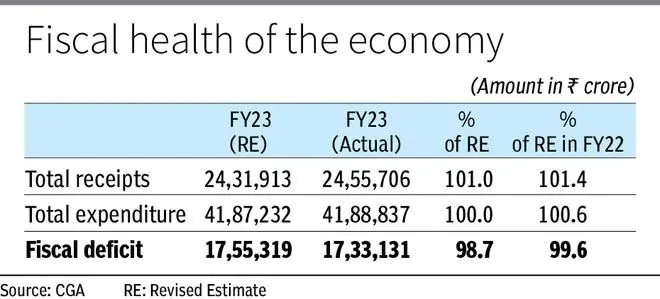The Centre has managed to keep the fiscal deficit at ₹17.3-lakh crore during fiscal year 2022-23 (FY23), lower than the revised estimate target of ₹17.55- lakh crore, data posted by Controller General of Accounts (CGA) showed.
However, in terms of percentage of GDP (Gross Domestic Products), it remains at 6.4 per cent considering expansion of size of economy.
Meanwhile, deficit in first month of current fiscal (Fiscal Year 2023-24 or FY 24) surged to ₹1.4-lakh crore mainly on account of lower revenue, another set of CGA data revealed. Fiscal deficit is difference between the government’s income and expenditure.
Accounts break-up
For the full fiscal, according to CGA data, Centre received over ₹24.56-lakh crore which is 101 per cent of revised estimate (RE) of 2022-23. Total expenditure incurred by Centre was ₹41.89-lakh crore, which is 100 per cent of RE 22-23, out of which ₹34.53-lakh crore is on the revenue account and ₹7.36-lakh crore is on capital account.
Out of the total revenue expenditure, ₹9.28-lakh crore is on account of interest payments, and over ₹5.3-lakh crore is on account of major subsidies.
In a note, Sunil Kumar Sinha (Principal Economist) and Paras Jasrai (Senior Analyst) of India Ratings & Research (Ind-Ra) said that the government has continued it focus on capex.
The capex (Capital Expenditure) in FY23 (provisional) was 101.1 per cent of FY23 (RE). Improvement in fiscal deficit from FY23 (RE) was mainly due to continued good performance of tax and non-tax revenue.
“While the tax revenue was 0.5 per cent higher than FY23 RE, the non-tax revenue was 9.3 per cent higher than FY23 (RE) in FY23 (provisional), compensating for the lackluster performance of non-debt capital receipts (86.5 per cent of FY23 RE),” the note said.

Echoing the same sentiment, Aditi Nayar, Chief Economist ICRA Ltd said the Central government was able to restrict its FY23 fiscal deficit a shade below the FY23 RE, with higher than estimated revenue receipts and a small undershooting in revenue expenditure, offsetting the disinvestment miss and a healthier than expected capex.
April Data
Talking about April deficit data, Sinha and Jasrai remarked that one should not read too much and infer from the financial position in the said month.
However, the important point is that, in the said month, number is continued buoyancy of GST. Central GST grew 26.2 per cent. Going forward, on y-o-y basis, nominal GDP growth is likely to slow down mainly due to decline in both wholesale and retail prices.
“Ind-Ra expects if government’s non-debt capital receipts target is achieved, it will not be very difficult for government to achieve its FY24 fiscal deficit target,” they said.
Nayar expects the higher than budgeted dividend surplus transfer of ₹87,420 crore from the RBI is likely to provide some cushion to meet any undershooting in other revenues streams or overshooting in expenses, relative to respective budget estimates.
Moreover, ICRA expects the fertilizer budgetary allocation for FY24 to remain adequate, at the current juncture, she added.
“While fiscal concerns appear limited and the MPC seems unlikely to raise policy rates further in the immediate term, higher state government borrowings in the coming months could keep the 10-year G-sec yield in a range of 7-7.2 per cent in the remainder of H1 FY24,” she said.








Comments
Comments have to be in English, and in full sentences. They cannot be abusive or personal. Please abide by our community guidelines for posting your comments.
We have migrated to a new commenting platform. If you are already a registered user of TheHindu Businessline and logged in, you may continue to engage with our articles. If you do not have an account please register and login to post comments. Users can access their older comments by logging into their accounts on Vuukle.